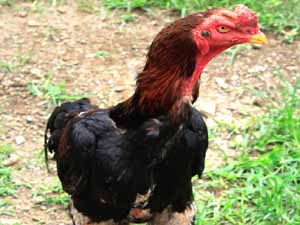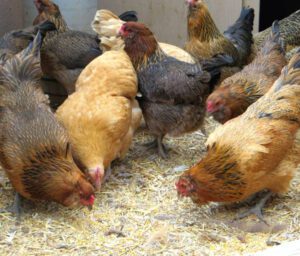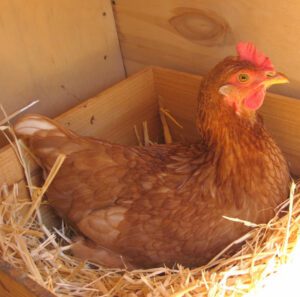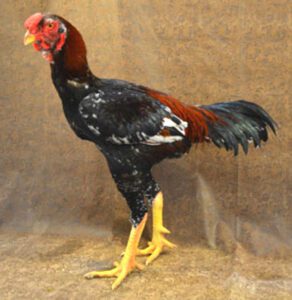Japanese bantam chicken is a tiny breed which is known for it’s size, extremely short legs, large combs and graceful arched tails. It is also known as Chabo, Shojo Chabo and Katsura Chabo. The word “Chabo” means bantam, dwarf or miniature in Japanese.
As it’s name suggest the ‘Japanese bantam chicken’ is an Asiatic chicken breed originating in Japan. It is a true bantam breed, meaning that there are no large fowl counterparts, and it is not and never was bred as a standard size chicken. It is an unusual breed and one of the few chicken breeds that is a true bantam.
Now this chicken breed is a strictly ornamental bird that is well liked by poultry fanciers. And the breed is very popular. The American Bantam Association considers the Japanese Bantam chicken breed to be in the top ten most popular breeds of all breeds.
The breed was recognized and admitted into the American Poultry Association’s Standard of Perfection in 1874.
Japanese Bantam Chicken Characteristics
Miniature size, large combs, extremely short legs and graceful arched tails are the main characteristics of this chicken breed. It has a large, upright tail that sits forward on the body creating a V-Shaped appearance.
Wings are held at a downward angle and are large in size. The wings in combination with their short legs, causes the wings to touch the ground. Their legs are of yellow color.
The comb, wattles and earlobes of these chickens are usually large in the males and medium in the females. And all are of bright or dark red in color. Their comb is single with five well defined points that stand upright.
Their eyes are dark brown or reddish bay and their beak is in shades of yellow. Their skin color is yellow. There are many color varieties of Japanese bantam chicken. But all the color varieties are not recognized by the American Poultry Association.
The American Poultry Association recognizes several color varieties, and those are; Black, Barred, Brown Red, Black tailed Buff, Black tailed White, Gray, Mottled, Wheaten and White. There are also frizzle-feathered and Silkie-feathered variations available of the Japanese bantam chicken.
On an average, the males weight about 510-600 grams and the females weight about 400-500 grams.

Behavior/Temperament
The Japanese bantam chicken is an extraordinary, ornamental breed. It was originally favored as ornamental garden birds by the aristocratic class of Japanese society. It can be a difficult chicken breed for the new poultry keepers because of it’s form.
And it’s plumage is difficult to achieve and requires extra attention and care. The breed suffers with a lethal gene combination that causes 25% of chicks to be unable to hatch. Breeding for good type is not easy. That’s why it’s not recommended for the beginners.
This chicken breed is easy to tame, though roosters might be aggressive. They are not a hardy breed and can be good fliers. Hens make a good broody and are excellent mothers.
Their chicks hatch after 20 days of incubation. The breed is not suitable for cold areas. Because their large comb and wattles are prone to frostbite.
During winter, they must be kept in a tight and warm coop with supplemental heat if needed. It is usually a gentle bird and a good forager in warm dry weather. Hens are not good layers. They lay a fair amount of small eggs.
Special Notes
The Japanese bantam chicken is an ideal breed for the people who are fond of their lawns and gardens. Because it is not good digger and it’s short legs stop them from damaging the ground.
The Japanese bantam chickens should be kept in a very clean chicken house, because their wingtips touch the ground and can be easily soiled.
They make excellent pets and are long lived birds. The average lifespan of Japanese bantam chicken is up to 13 years with proper care. Review full breed profile of Japanese bantam chicken below.
| Breed Name | Japanese Bantam |
| Other Name | Also known as Chabo, Shojo Chabo and Katsura Chabo |
| Breed Purpose | Ornamental breed |
| Breed Temperament | Friendly, calm, easily tamed, bears confinement well, roosters might be aggressive |
| Breed Size | True Bantam |
| Broodiness | Average |
| Comb | Single |
| Climate Tolerance | All Climates but not cold hardy |
| Egg Color | Cream or Tinted |
| Egg Size | Small |
| Egg Productivity | Low |
| Feathered Legs | No |
| Rarity | Common |
| Varieties | There are many color varieties of Japanese bantam chicken. But the American Poultry Association recognizes several color varieties, and those are; Black, Barred, Brown Red, Black tailed Buff, Black tailed White, Gray, Mottled, Wheaten and White. |
| Country of Origin | Japan |





